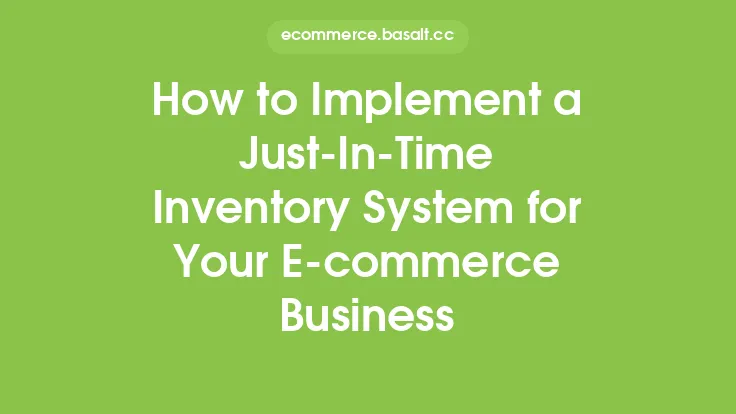As the e-commerce industry continues to grow and evolve, online businesses are facing increasing pressure to scale their operations efficiently. One key strategy for achieving this is through the automation of e-commerce processes. By leveraging technology to streamline and optimize various aspects of their operations, businesses can free up resources, reduce costs, and improve overall performance. In this article, we will explore the importance of automating e-commerce processes and provide insights into how businesses can implement automation to drive growth and success.
Understanding E-commerce Automation
E-commerce automation refers to the use of technology to automate repetitive, time-consuming, and often mundane tasks that are typically performed manually. This can include tasks such as order processing, inventory management, shipping and fulfillment, customer service, and marketing. By automating these tasks, businesses can reduce the risk of human error, increase productivity, and improve overall efficiency. E-commerce automation can be achieved through the use of various tools and software, including workflow automation platforms, robotic process automation (RPA) tools, and artificial intelligence (AI) and machine learning (ML) algorithms.
Benefits of E-commerce Automation
The benefits of e-commerce automation are numerous and well-documented. Some of the most significant advantages include:
- Increased efficiency: Automation enables businesses to process orders, manage inventory, and fulfill shipments more quickly and accurately, resulting in improved customer satisfaction and reduced costs.
- Improved accuracy: Automated systems can perform tasks with a high degree of accuracy, reducing the risk of human error and minimizing the need for manual intervention.
- Enhanced customer experience: Automation enables businesses to provide 24/7 customer support, respond to customer inquiries more quickly, and offer personalized recommendations and promotions.
- Reduced costs: Automation can help businesses reduce labor costs, minimize waste, and optimize inventory levels, resulting in significant cost savings.
- Scalability: Automation enables businesses to scale their operations more easily, as automated systems can handle increased volumes of traffic, orders, and customer inquiries without a corresponding increase in labor costs.
Key E-commerce Processes to Automate
There are several key e-commerce processes that businesses can automate to drive growth and success. Some of the most important processes to consider automating include:
- Order processing: Automating order processing can help businesses reduce errors, improve fulfillment rates, and enhance customer satisfaction.
- Inventory management: Automating inventory management can help businesses optimize inventory levels, reduce stockouts and overstocking, and improve supply chain efficiency.
- Shipping and fulfillment: Automating shipping and fulfillment can help businesses reduce shipping costs, improve delivery times, and enhance customer satisfaction.
- Customer service: Automating customer service can help businesses provide 24/7 support, respond to customer inquiries more quickly, and offer personalized recommendations and promotions.
- Marketing: Automating marketing can help businesses personalize promotions, optimize email campaigns, and improve social media engagement.
Implementing E-commerce Automation
Implementing e-commerce automation requires careful planning, execution, and monitoring. Some of the key steps to consider when implementing automation include:
- Identifying areas for automation: Businesses should identify areas of their operations where automation can have the greatest impact, such as order processing, inventory management, and customer service.
- Selecting automation tools: Businesses should select automation tools and software that are tailored to their specific needs and requirements.
- Configuring and testing automation systems: Businesses should configure and test automation systems to ensure they are working correctly and efficiently.
- Monitoring and optimizing automation systems: Businesses should continuously monitor and optimize automation systems to ensure they are delivering the desired benefits and returns on investment.
Best Practices for E-commerce Automation
To get the most out of e-commerce automation, businesses should follow best practices such as:
- Starting small: Businesses should start by automating small, discrete processes and then scale up to more complex tasks.
- Focusing on high-impact areas: Businesses should focus on automating areas that have the greatest impact on their operations, such as order processing and inventory management.
- Monitoring and optimizing automation systems: Businesses should continuously monitor and optimize automation systems to ensure they are delivering the desired benefits and returns on investment.
- Providing training and support: Businesses should provide training and support to employees to ensure they are comfortable using automation systems and can troubleshoot issues as they arise.
- Continuously evaluating and improving automation systems: Businesses should continuously evaluate and improve automation systems to ensure they are keeping pace with changing business needs and requirements.
Common Challenges and Limitations
While e-commerce automation offers numerous benefits, there are also common challenges and limitations that businesses should be aware of. Some of the most significant challenges and limitations include:
- Initial investment: Implementing automation can require a significant upfront investment in technology, software, and training.
- Complexity: Automation systems can be complex and require specialized expertise to configure and maintain.
- Integration: Automation systems may require integration with existing systems and software, which can be time-consuming and challenging.
- Change management: Automation can require significant changes to business processes and workflows, which can be difficult to implement and manage.
- Maintenance and support: Automation systems require ongoing maintenance and support to ensure they are working correctly and efficiently.
Future of E-commerce Automation
The future of e-commerce automation is exciting and rapidly evolving. Some of the most significant trends and developments include:
- Artificial intelligence (AI) and machine learning (ML): AI and ML are being used to automate increasingly complex tasks, such as customer service, marketing, and supply chain management.
- Robotic process automation (RPA): RPA is being used to automate repetitive, rule-based tasks, such as data entry and order processing.
- Internet of Things (IoT): IoT is being used to automate tasks such as inventory management and supply chain tracking.
- Cloud computing: Cloud computing is being used to provide scalable, on-demand access to automation software and systems.
- Big data and analytics: Big data and analytics are being used to provide insights and intelligence to inform automation decisions and optimize business processes.




